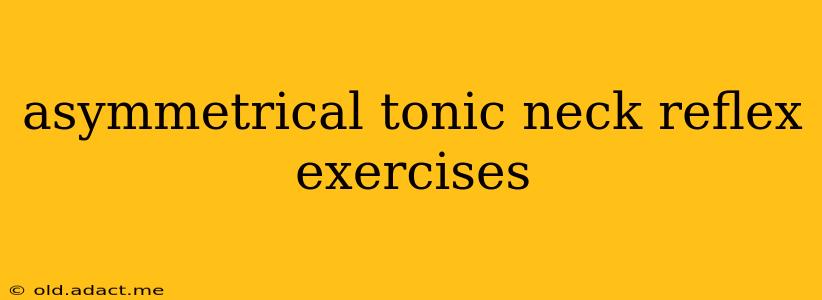The Asymmetrical Tonic Neck Reflex (ATNR), also known as the "fencing reflex," is a primitive reflex present in infants. While it's crucial for early development, its persistence beyond the typical age of integration (around 6 months) can hinder motor skills, coordination, and overall development. This article explores exercises designed to help integrate the ATNR, focusing on improving postural control, hand-eye coordination, and bilateral skills. We will also address common questions surrounding this reflex.
What is the Asymmetrical Tonic Neck Reflex (ATNR)?
The ATNR is characterized by a specific arm and leg response to head turning. When an infant turns their head to one side, the arm on that side extends while the opposite arm flexes. The legs mirror this pattern, with the leg on the same side as the extended arm also extending, and the opposite leg flexing. This reflex is vital in the early stages of development, helping babies prepare for rolling and crawling. However, persistent ATNR beyond the typical integration age can lead to challenges such as:
- Difficulty with crawling and creeping: The reflex can make it difficult to coordinate limbs for these crucial developmental milestones.
- Poor hand-eye coordination: The asymmetrical posture may interfere with activities requiring coordinated hand and eye movements.
- Problems with reading and writing: Persistent ATNR can affect posture and fine motor control necessary for these tasks.
- Difficulties with sports and other activities: Coordination issues stemming from the reflex can hinder participation in physical activities.
How Can I Tell if My Child Still Has the ATNR?
Observing your child's posture and movement is crucial. Signs of a persistent ATNR may include:
- Difficulty crossing the midline: Struggling to reach across the body with either hand.
- Preference for one side: Consistently favoring one side of the body for activities.
- Poor balance: Difficulty maintaining balance, particularly when reaching.
- Awkward crawling pattern: An unusual or asymmetrical crawling pattern.
What Exercises Can Help Integrate the ATNR?
Integrating the ATNR requires a multifaceted approach involving activities designed to promote symmetrical movements and enhance body awareness. These exercises should be introduced gradually and playfully to encourage participation:
1. Midline Activities:
These activities encourage the child to bring their hands across the midline of their body, directly challenging the asymmetrical pattern of the ATNR. Examples include:
- Playing with toys across the body: Encourage the child to reach for toys placed across their midline.
- Clapping games: Clapping hands together, alternating hands, and rhythmic clapping.
- Stacking blocks: Building towers using blocks, requiring hand-eye coordination and midline crossing.
2. Symmetrical Activities:
These exercises encourage balanced movement and coordination between both sides of the body. Examples include:
- Rolling on a ball: Gently rolling the child back and forth on a large ball, promoting symmetrical movement.
- Swimming: The symmetrical movements in swimming are excellent for ATNR integration.
- Bicycle kicks: Lying on the back and performing bicycle kicks, promoting symmetrical leg movements.
- Mirror exercises: Imitating movements done by another person, to promote symmetry and coordination.
3. Postural Exercises:
These activities aim to improve postural control and stability, which are often affected by a persistent ATNR. Examples include:
- Standing on one leg: Working on balance and unilateral stability.
- Reaching activities: Reaching for objects while maintaining balance, both from a standing and sitting position.
- Plank exercises (modified): Simple, short planks (modified to suit the child’s ability) promote core strength.
What if Exercises Don't Seem to Help?
If you are concerned about your child's development and suspect a persistent ATNR, it's crucial to consult a qualified professional such as a pediatric occupational therapist, physical therapist, or developmental pediatrician. They can perform a thorough assessment, provide a personalized treatment plan, and address any underlying issues.
At What Age Should ATNR Be Integrated?
The ATNR typically integrates around 6 months of age. Persistence beyond this age often requires professional intervention. Early identification and intervention are crucial for optimal development.
Can Adults Still Have the ATNR?
While the ATNR is typically integrated early in infancy, residual effects can sometimes be present in adults. These effects may manifest as posture issues, awkward movement patterns, or difficulty performing specific tasks. A physical therapist can assess for such issues and implement corrective exercises if needed.
This information is intended for educational purposes only and does not constitute medical advice. Always consult with a healthcare professional before starting any new exercise program, especially for children with developmental concerns. Remember consistency and patience are key when working through these exercises; celebrate small victories and keep building toward your child's motor milestones!
